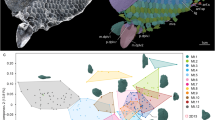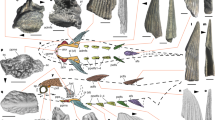Abstract
Living gnathostomes (jawed vertebrates) include chondrichthyans (sharks, rays and chimaeras) and osteichthyans or bony fishes. Living osteichthyans are divided into two lineages, namely actinopterygians (bichirs, sturgeons, gars, bowfins and teleosts) and sarcopterygians (coelacanths, lungfishes and tetrapods). It remains unclear how the two osteichthyan lineages acquired their respective characters and how their common osteichthyan ancestor arose from non-osteichthyan gnathostome groups1, 2. Here we present the first tentative reconstruction of a 400-million-year-old fossil fish from China (Fig. 1); this fossil fish combines features of sarcopterygians and actinopterygians and yet possesses large, paired fin spines previously found only in two extinct gnathostome groups (placoderms and acanthodians). This early bony fish provides a morphological link between osteichthyans and non-osteichthyan groups. It changes the polarity of many characters used at present in reconstructing osteichthyan inter-relationships and offers new insights into the origin and evolution of osteichthyans.

a, Head and anterior part of the fish with tentatively positioned median fin spine. b, Anterior view of the skull and lower jaws (from ref. 3). Scale bar, 5 mm. c, Median fin spine (from ref. 4). d, Shoulder girdle with pectoral spine, based on specimens shown in Fig. 2. e, Cheek plate with maxillary and preopercular, based on specimens shown in Fig. 3. Surface ornamentation of the cheek plate is omitted to show the pattern of sensory canals. Most Psarolepis specimens derive from four beds at the same locality in Qujing, Yunnan, China.
This is a preview of subscription content, access via your institution
Access options
Subscribe to this journal
Receive 51 print issues and online access
$199.00 per year
only $3.90 per issue
Buy this article
- Purchase on Springer Link
- Instant access to full article PDF
Prices may be subject to local taxes which are calculated during checkout



Similar content being viewed by others
References
Janvier, P. Early Vertebrates (Oxford Univ. Press, Oxford, (1996 )).
Rosen, D. E., Forey, P. L., Gardiner, B. G. & Patterson, C. Lungfishes, tetrapods, paleontology and plesiomorphy. Bull. Am. Mus. Nat. Hist. 167, 159–276 (1981).
Yu, X. Anew porolepiform-like fish, Psarolepis romeri, gen. et. sp. nov. (Sarcopterygii, Osteichthyes) from the Lower Devonian of Yunnan, China. J. Vert. Paleontol. 18, 261–274 ( 1998).
Zhu, M. & Schultz, H. -P. The oldest sarcopterygian fish. Lethaia 30, 293–304 (1997).
Tong-Duzy, T., Ta-Hoa, P., Boucot, A. J., Goujet, D. & Janvier, P. Vertébrés siluriens du Viet-nam central. C.R. Acad. Sci. Abstr. 32, 1023–1030 (1997).
Gardiner, B. G. The relationships of the palaeoniscid fishes, a review based on new specimens of Mimia and Moythomasia from the Upper Devonian of Western Australia. Bull. Brit. Mus. Nat. Hist. 37, 173–428 (1984).
Otto, M. Zur systematischen Stellung der Lophosteiden (Obersilur, Pisces inc. sedis). Paläont. Z. 65, 345–350 (1993).
Schultze, H. -P. Ausgangform und Enterwicklung der rhombischen Schuppen der Osteichthyes (Pisces). Paläont. Z. 51, 152– 168 (1977).
Janvier, P. On the oldest known teleostome fish Andreolepis hedei Gross (Ludlow of Gotland), and the systematic position of the lophosteids. Eesti NSV Teaduste Akadeemia Toimetised Geol. 27, 86– 95 (1978).
Chang, M. M. in Early Vertebrates and Related Problems of Evolutionary Biology (eds Chang, M. M., Liu, Y. H. & Zhang, G. R.) 355–378 (Science Press, Beijing, (1991)).
Chang, M. M. & Zhu, M. Anew Middle Devonian osteolepidid from Qujing, Yunnan. Mem. Ass. Australas. Palaeontols. 15 , 183–198 (1993).
Jessen, H. L. Lower Devonian Porolepiformes from the Canadian Arctic with special reference to Powichthys thorsteinssoni Jessen. Palaeontogr. Abt A 167, 180–214 ( 1980).
Ahlberg, P. E. Are-examination of sarcopterygian interrelationships, with special reference to the Porolepiformes. Zool. J. Linn. Soc. 103, 241–287 (1991).
Cloutier, R. & Ahlberg, P. E. in Interrelationships of Fishes (eds Stiassny, M. L., Parenti, L. R. & Johnson, G. D.) 445 –480 (Academic, New York, (1996)).
Swofford, D. L. PAUP: phylogenetic analysis using parsimony, version 3.1.1 (( 1993)).
Jarvik, E. Basic structure and evolution of vertebrates. Vol. 2(Academic, London, (1981)).
Andrews, S. M. in Interrelationships of Fishes (eds Miles, R. S. & Patterson, C.) 137–177 (Academic, London, (1973)).
Bjerring, H. The ‘intercranial joint’ vs the ‘ventral otic fissure’. Act. Zool. Stockh. 59, 203– 214 (1978).
Acknowledgements
We thank H.-P. Schultze, M. M. Chang and P. E. Ahlberg for useful discussons; W.Harre for the photographs and P. E. Ahlberg, M. I. Coates and M. M. Smith for comments and suggestions. M.Z. acknowledges support from the Alexander von Humboldt Foundation and the Chinese academy of Sciences. X.Y. thanks IVPP for access to specimens and Kean University for support for research and faculty development.
Author information
Authors and Affiliations
Corresponding author
Supplementary information
Rights and permissions
About this article
Cite this article
Zhu, M., Yu, X. & Janvier, P. A primitive fossil fish sheds light on the origin of bony fishes. Nature 397, 607–610 (1999). https://doi.org/10.1038/17594
Received:
Accepted:
Issue Date:
DOI: https://doi.org/10.1038/17594
This article is cited by
-
Bony-fish-like scales in a Silurian maxillate placoderm
Nature Communications (2023)
-
The Silurian-Devonian boundary in East Yunnan (South China) and the minimum constraint for the lungfish-tetrapod split
Science China Earth Sciences (2021)
-
Scale morphology and squamation pattern of Guiyu oneiros provide new insights into early osteichthyan body plan
Scientific Reports (2019)
-
Phylogenetic classification of bony fishes
BMC Evolutionary Biology (2017)
-
Fin modules: an evolutionary perspective on appendage disparity in basal vertebrates
BMC Biology (2017)
Comments
By submitting a comment you agree to abide by our Terms and Community Guidelines. If you find something abusive or that does not comply with our terms or guidelines please flag it as inappropriate.



